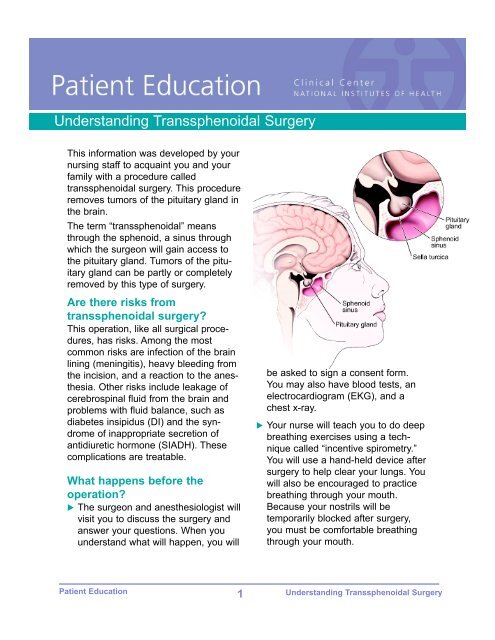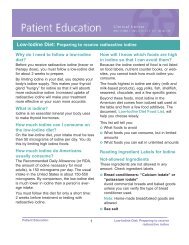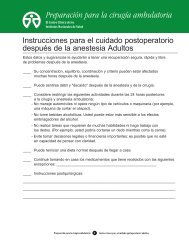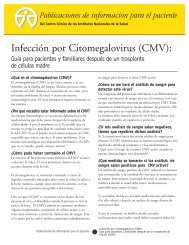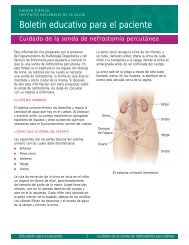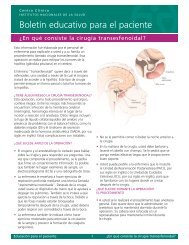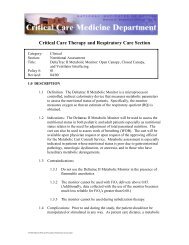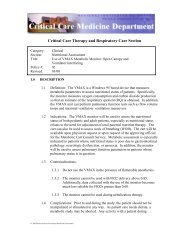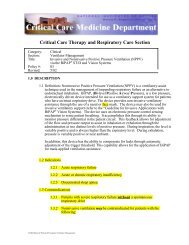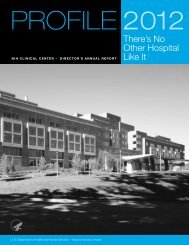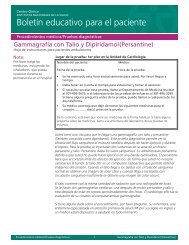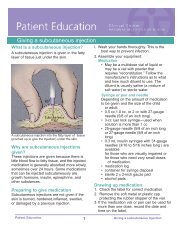Understanding Transsphenoidal Surgery
Understanding Transsphenoidal Surgery
Understanding Transsphenoidal Surgery
Create successful ePaper yourself
Turn your PDF publications into a flip-book with our unique Google optimized e-Paper software.
<strong>Understanding</strong> <strong>Transsphenoidal</strong> <strong>Surgery</strong><br />
This information was developed by your<br />
nursing staff to acquaint you and your<br />
family with a procedure called<br />
transsphenoidal surgery. This procedure<br />
removes tumors of the pituitary gland in<br />
the brain.<br />
The term “transsphenoidal” means<br />
through the sphenoid, a sinus through<br />
which the surgeon will gain access to<br />
the pituitary gland. Tumors of the pituitary<br />
gland can be partly or completely<br />
removed by this type of surgery.<br />
Are there risks from<br />
transsphenoidal surgery?<br />
This operation, like all surgical procedures,<br />
has risks. Among the most<br />
common risks are infection of the brain<br />
lining (meningitis), heavy bleeding from<br />
the incision, and a reaction to the anesthesia.<br />
Other risks include leakage of<br />
cerebrospinal fluid from the brain and<br />
problems with fluid balance, such as<br />
diabetes insipidus (DI) and the syndrome<br />
of inappropriate secretion of<br />
antidiuretic hormone (SIADH). These<br />
complications are treatable.<br />
What happens before the<br />
operation?<br />
The surgeon and anesthesiologist will<br />
visit you to discuss the surgery and<br />
answer your questions. When you<br />
understand what will happen, you will<br />
be asked to sign a consent form.<br />
You may also have blood tests, an<br />
electrocardiogram (EKG), and a<br />
chest x-ray.<br />
Your nurse will teach you to do deep<br />
breathing exercises using a technique<br />
called “incentive spirometry.”<br />
You will use a hand-held device after<br />
surgery to help clear your lungs. You<br />
will also be encouraged to practice<br />
breathing through your mouth.<br />
Because your nostrils will be<br />
temporarily blocked after surgery,<br />
you must be comfortable breathing<br />
through your mouth.<br />
Patient Education 1 <strong>Understanding</strong> <strong>Transsphenoidal</strong> <strong>Surgery</strong><br />
Clinica<br />
Nation
Your nurse will also show you how to<br />
do gentle exercises to promote blood<br />
circulation and prevent blood clots.<br />
The night before surgery, you will not<br />
be allowed to eat or drink.<br />
The morning of surgery, you should<br />
bathe and shampoo your hair. You will<br />
be asked to put on full-length support<br />
stockings..<br />
You may ask your nurse to show you<br />
the Post-Anesthesia Care Unit (PACU)<br />
or the Intensive Care Unit (ICU) so<br />
that you will know your surroundings<br />
after surgery.<br />
What happens during the<br />
operation?<br />
The procedure<br />
You will be placed under general anesthesia.<br />
This means that you will be<br />
given an anesthetic that will keep you<br />
asleep during the operation. Your head<br />
will be placed in a headrest to keep it<br />
still during surgery.<br />
The surgeon will make an incision<br />
under the upper lip along your gum<br />
line.<br />
The bottom of the pituitary chamber<br />
will be entered through the base of<br />
the nose and the sphenoid sinus.<br />
Part of the pituitary chamber will be<br />
removed so that the surgeon can<br />
see the pituitary gland.<br />
The tissue covering the pituitary gland<br />
will be cut open. The surgeon will<br />
remove the tumor with special instruments.<br />
When the tumor is taken out,<br />
the bottom of the pituitary chamber will<br />
be replaced with pieces of bone that<br />
were removed earlier in the procedure.<br />
The incision will be closed, and your<br />
nostrils will be packed with gauze or a<br />
special nasal sponge. The tumor will<br />
then be sent to the laboratory for<br />
examination.<br />
The fat graft<br />
Sometimes a small piece of fat will be<br />
taken from your abdomen and packed<br />
into the pituitary chamber. This is done to<br />
prevent brain fluid from leaking.<br />
What happens after the<br />
operation?<br />
Immediately after surgery, you will be<br />
taken to the PACU. You will be monitored<br />
closely until you are ready to be taken to<br />
your patient care unit. You will stay on<br />
the unit for 2 to 5 days.<br />
Your bed position after surgery<br />
The head of your bed will be slightly<br />
raised (30 degrees) to promote blood<br />
flow from your head and decrease the<br />
fluid pressure in your head. If you have<br />
a spinal drain in place, you will lie flat.<br />
Patient Education 2 <strong>Understanding</strong> <strong>Transsphenoidal</strong> <strong>Surgery</strong>
Nasal packing<br />
Both your nostrils will be packed for<br />
1 to 3 days after surgery. You will breathe<br />
through your mouth while your nostrils are<br />
packed. Because your lips will probably<br />
become dry, your nurse will give you a<br />
soothing gel for them. You will also be<br />
thirsty. Most patients say that the nasal<br />
packing is uncomfortable, and may cause a<br />
headache. Be sure to ask your nurse for<br />
pain medication.<br />
When the packing is removed, there will be<br />
some bleeding and drainage from your<br />
nose. Your nurse will place a small piece of<br />
gauze under your nose to collect this discharge.<br />
The discharge should stop in a few<br />
days.<br />
Incisions<br />
The incision that was made under the<br />
upper lip along the gumline will be closed<br />
with stitches. These stitches will dissolve in<br />
7 to 10 days. If you had a fat graft, there<br />
will be a small gauze dressing over the site<br />
on your abdomen from which the fat was<br />
taken.<br />
Brushing your teeth and bathing<br />
Do not brush your teeth using a regular<br />
toothbrush for at least 14 days after surgery.<br />
Your nurse will provide you with a<br />
special, ultra-soft toothbrush. You will also<br />
be given a special mouthwash and swabs<br />
with which to rinse your mouth throughout<br />
the day, especially after eating and drinking.<br />
This mouthwash helps rinse away dried<br />
blood and helps your incision heal.<br />
The incision in your mouth will be stitched<br />
closed from the inside. You may bathe<br />
when your doctor gives you permission.<br />
Urinary catheter<br />
During surgery, a urinary catheter will be<br />
placed in your bladder to drain your urine.<br />
This catheter will stay in place for about 1<br />
to 2 days after surgery.<br />
Lumbar drain<br />
Sometimes after surgery, the surgeon will<br />
insert a very small catheter in your lower<br />
back. This catheter, called a “lumbar drain,”<br />
is placed in the spinal canal. This catheter<br />
is not usually needed, but it may be used to<br />
allow fluid to flow away from the incision so<br />
that it can heal. If it is used, this drain will<br />
stay in place for 3 to 5 days after surgery.<br />
You must lie flat in bed if you have this<br />
drain, but you may turn side to side.<br />
Diabetes insipidus<br />
Diabetes insipidus is a condition that<br />
occurs when your pituitary gland does<br />
not secrete enough ADH (antidiuretic<br />
hormone). This hormone regulates your<br />
urine output. Diabetes insipidus may<br />
occur as a result of the pituitary gland<br />
being disturbed during surgery. The three<br />
signs of diabetes insipidus are:<br />
Increased urine output<br />
Dilute urine and very light yellow in color<br />
Increased thirst<br />
If you have these signs, report them to<br />
your nurse. Diabetes insipidus caused by<br />
surgery is temporary and treatable.<br />
Patient Education 3 <strong>Understanding</strong> <strong>Transsphenoidal</strong> <strong>Surgery</strong>
Activity<br />
After surgery, be careful about doing<br />
certain types of physical activities. It is<br />
especially important not to cough, blow or<br />
pick your nose, sneeze, bend over, or<br />
strain for at least 1 month after surgery. If<br />
you feel an urge to sneeze, do not try to<br />
hold back the sneeze; sneeze with your<br />
mouth open. Here are listed some activities<br />
and when you will be able to do them<br />
after surgery.<br />
bending below the level of the knee:<br />
4 weeks<br />
sneezing, coughing, blowing nose:<br />
4 weeks<br />
aerobics, swimming, other exercise:<br />
4 weeks<br />
brushing front teeth gently: 2 weeks<br />
returning to work: 3 to 6 weeks<br />
showering, washing hair: no restriction<br />
wearing contact lenses: no restriction<br />
wearing dentures/partial plate: 2 weeks<br />
(or when comfortable)<br />
10/08<br />
Closing notes<br />
Remember to be patient with yourself<br />
and to focus on positive thinking during<br />
recovery. You play a large part in helping<br />
to assure your well-being after surgery.<br />
If you have questions about transsphenoidal<br />
surgery, please feel free to speak<br />
with your nurse or doctor.<br />
Patient Education 4<br />
<strong>Understanding</strong> <strong>Transsphenoidal</strong> <strong>Surgery</strong>


